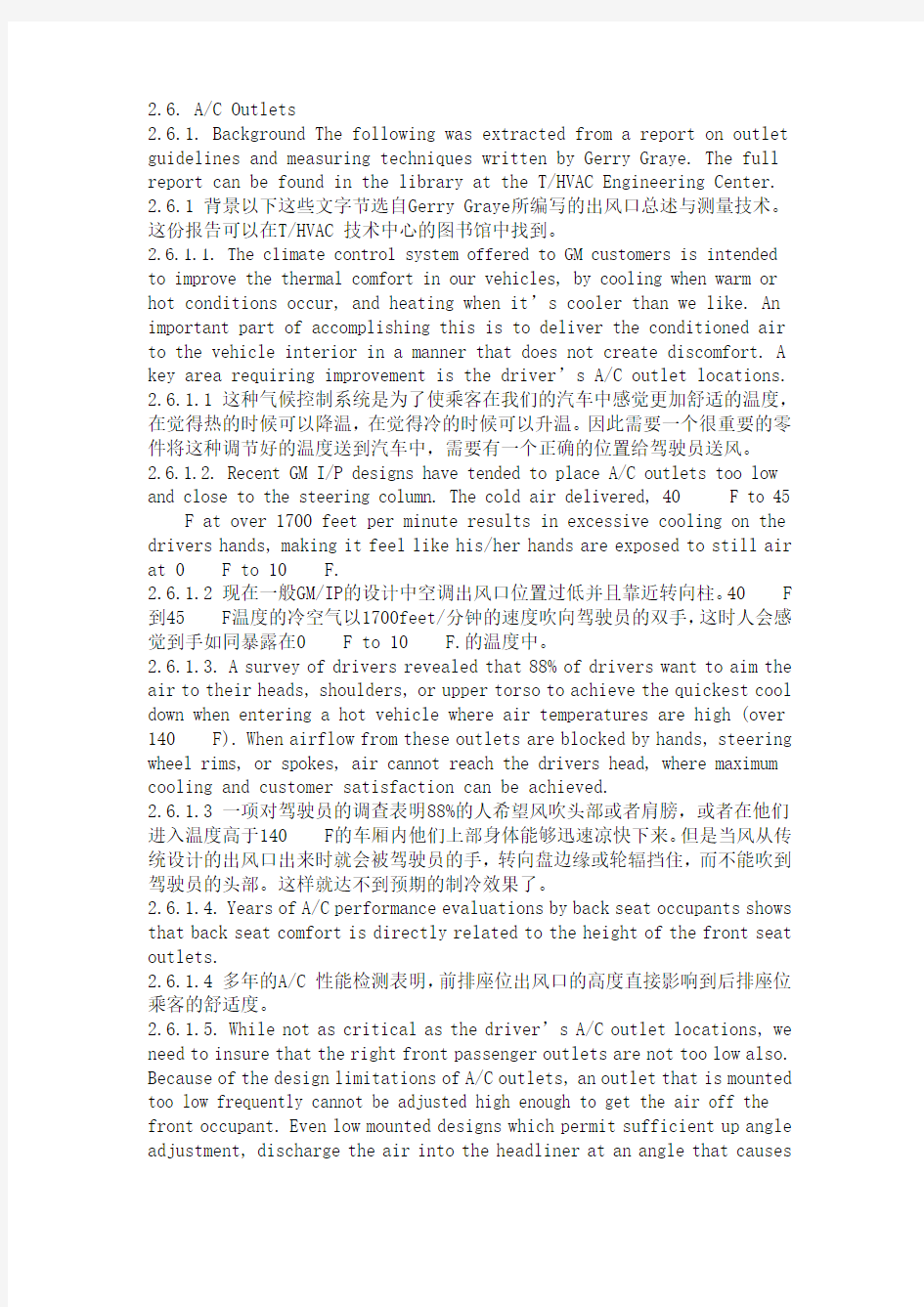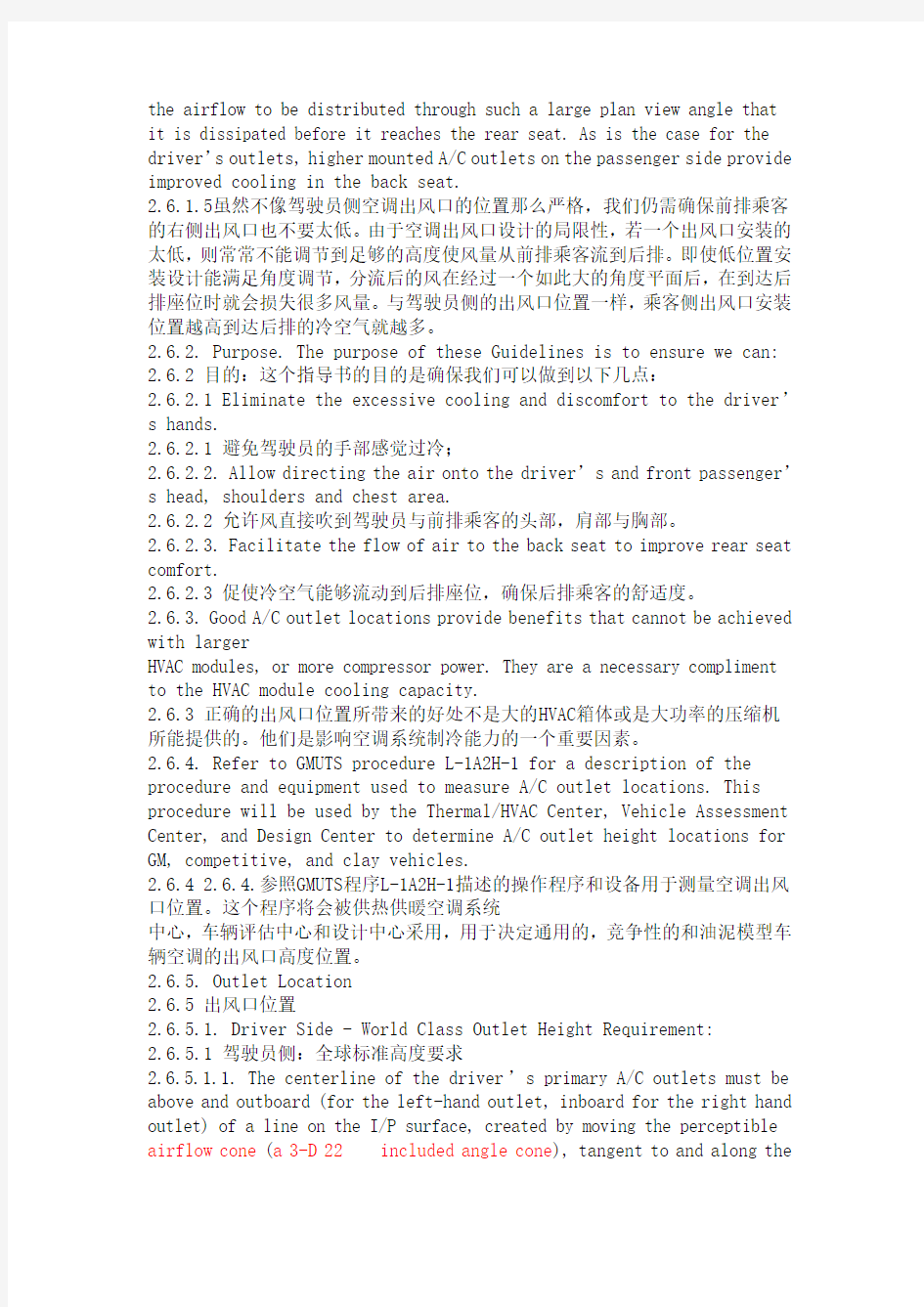

2.6. A/C Outlets
2.6.1. Background The following was extracted from a report on outlet guidelines and measuring techniques written by Gerry Graye. The full report can be found in the library at the T/HVAC Engineering Center.
2.6.1 背景以下这些文字节选自Gerry Graye所编写的出风口总述与测量技术。这份报告可以在T/HVAC 技术中心的图书馆中找到。
2.6.1.1. The climate control system offered to GM customers is intended to improve the thermal comfort in our vehicles, by cooling when warm or hot conditions occur, and heating when it’s cooler than we like. An important part of accomplishing this is to deliver the conditioned air to the vehicle interior in a manner that does not create discomfort. A key area requiring improvement is the driver’s A/C outlet locations.
2.6.1.1 这种气候控制系统是为了使乘客在我们的汽车中感觉更加舒适的温度,在觉得热的时候可以降温,在觉得冷的时候可以升温。因此需要一个很重要的零件将这种调节好的温度送到汽车中,需要有一个正确的位置给驾驶员送风。
2.6.1.2. Recent GM I/P designs have tended to place A/C outlets too low and close to the steering column. The cold air delivered, 40 F to 45 F at over 1700 feet per minute results in excessive cooling on the drivers hands, making it feel like his/her hands are exposed to still air at 0 F to 10 F.
2.6.1.2 现在一般GM/IP的设计中空调出风口位置过低并且靠近转向柱。40 F 到45 F温度的冷空气以1700feet/分钟的速度吹向驾驶员的双手,这时人会感觉到手如同暴露在0 F to 10 F.的温度中。
2.6.1.
3. A survey of drivers revealed that 88% of drivers want to aim the air to their heads, shoulders, or upper torso to achieve the quickest cool down when entering a hot vehicle where air temperatures are high (over 140 F). When airflow from these outlets are blocked by hands, steering wheel rims, or spokes, air cannot reach the drivers head, where maximum cooling and customer satisfaction can be achieved.
2.6.1.3 一项对驾驶员的调查表明88%的人希望风吹头部或者肩膀,或者在他们进入温度高于140 F的车厢内他们上部身体能够迅速凉快下来。但是当风从传统设计的出风口出来时就会被驾驶员的手,转向盘边缘或轮辐挡住,而不能吹到驾驶员的头部。这样就达不到预期的制冷效果了。
2.6.1.4. Years of A/C performance evaluations by back seat occupants shows that back seat comfort is directly related to the height of the front seat outlets.
2.6.1.4 多年的A/C 性能检测表明,前排座位出风口的高度直接影响到后排座位乘客的舒适度。
2.6.1.5. While not as critical as the driver’s A/C outlet locations, we need to insure that the right front passenger outlets are not too low also. Because of the design limitations of A/C outlets, an outlet that is mounted too low frequently cannot be adjusted high enough to get the air off the front occupant. Even low mounted designs which permit sufficient up angle adjustment, discharge the air into the headliner at an angle that causes
the airflow to be distributed through such a large plan view angle that it is dissipated before it reaches the rear seat. As is the case for the driver’s outlets, higher mounted A/C outlets on the passenger side provide improved cooling in the back seat.
2.6.1.5虽然不像驾驶员侧空调出风口的位置那么严格,我们仍需确保前排乘客的右侧出风口也不要太低。由于空调出风口设计的局限性,若一个出风口安装的太低,则常常不能调节到足够的高度使风量从前排乘客流到后排。即使低位置安装设计能满足角度调节,分流后的风在经过一个如此大的角度平面后,在到达后排座位时就会损失很多风量。与驾驶员侧的出风口位置一样,乘客侧出风口安装位置越高到达后排的冷空气就越多。
2.6.2. Purpose. The purpose of these Guidelines is to ensure we can: 2.6.2 目的:这个指导书的目的是确保我们可以做到以下几点:
2.6.2.1 Eliminate the excessive cooling and discomfort to the driver’s hands.
2.6.2.1 避免驾驶员的手部感觉过冷;
2.6.2.2. Allow directing the air onto the driver’s and front passenger’s head, shoulders and chest area.
2.6.2.2 允许风直接吹到驾驶员与前排乘客的头部,肩部与胸部。
2.6.2.
3. Facilitate the flow of air to the back seat to improve rear seat comfort.
2.6.2.3 促使冷空气能够流动到后排座位,确保后排乘客的舒适度。
2.6.
3. Good A/C outlet locations provide benefits that cannot be achieved with larger
HVAC modules, or more compressor power. They are a necessary compliment to the HVAC module cooling capacity.
2.6.3 正确的出风口位置所带来的好处不是大的HVAC箱体或是大功率的压缩机所能提供的。他们是影响空调系统制冷能力的一个重要因素。
2.6.4. Refer to GMUTS procedure L-1A2H-1 for a description of the procedure and equipment used to measure A/C outlet locations. This procedure will be used by the Thermal/HVAC Center, Vehicle Assessment Center, and Design Center to determine A/C outlet height locations for GM, competitive, and clay vehicles.
2.6.4 2.6.4.参照GMUTS程序L-1A2H-1描述的操作程序和设备用于测量空调出风口位置。这个程序将会被供热供暖空调系统
中心,车辆评估中心和设计中心采用,用于决定通用的,竞争性的和油泥模型车辆空调的出风口高度位置。
2.6.5. Outlet Location
2.6.5 出风口位置
2.6.5.1. Driver Side - World Class Outlet Height Requirement:
2.6.5.1 驾驶员侧:全球标准高度要求
2.6.5.1.1. The centerline of the driver’s primary A/C outlets must be above and outboard (for the left-hand outlet, inboard for the right hand outlet) of a line on the I/P surface, created by moving the perceptible airflow cone(a 3-D 22 included angle cone), tangent to and along the
surface of50th %ile (UMTRI)hands placed at the 9 and 3 o’clock positions on the steering wheel.
2.6.5.1.1.驾驶员位置的主要空调出风口的中心线必须在仪表板表面上的一条线之上及在其外侧(是指左边的出风口,右边的出风口则是在内侧),移动可知的出风空气流柱(一个3D的22 内的圆锥里),相切且沿着50%假人的(UMTRI)手放在方向盘正左和正右的的位置的表面而得出。
2.6.5.1.2. The centerline of the A/C outlet shall also be above / outboard of a line on the I/P surface created by moving a 3-D 11 included angle cone (representing the fastest and coldest airflow, comprising 50% of the flow from an outlet) tangent to the surface of the wheel rim above the hands. See Figures 1 & 2. (The cone centerline is tangent to the underside of the eye ellipse in the side view, and centered on the same side eye ellipse center point in the plan view.
2.6.5.1.2这个出风口的中心线也应在仪表板表面上的一条线之上及在其外侧,移动3D的11 圆锥(代表速度最快和最冷的空气流,包含了50%的从出风口吹出的空气)与握在方向盘上轮缘的手表面相切而得出。见图 、 (在侧视图里圆锥的中心线与眼椭圆下部相切,在前视图里中心线在眼椭圆的中心点位置。)2.6.5.1.
3. Rear seat A/C outlets should be used if the outlet location does not meet this height requirement. (See Design Procedure 1.1 - Outlet Location, Driver Side World Class Height)
2.6.5.1.3 如果驾驶员侧出风口达不到以上要求,那么就应该对后排作为出风口位置进行规定。
FIGURE 1. DRIVER SIDE WORLD CLASS OUTLET HEIGHT, SIDE VIEW
Flat I/P surface shown for simplicity here. Use actual/proposed I/P surface. Steering column & wheel design position -no tilt angle
图1 驾驶员侧出风口位置高度全球标准,侧视图
简单的示意出仪表台表面,并以实际仪表台表面为基准;转向柱以及方向盘的设计位置- 无斜度。
FIGURE 2. DRIVER SIDE WORLD CLASS OUTLET HEIGHT, FRONT VIEW Proposed World Class Outlet Height projected onto actual I/P surface 图2 前视图
出风口位置在仪表台上表面的正确位置。
2.6.5.2. Passenger Side - World Class A/C Outlet Height on I/P Requirement:
2.6.5.2 乘客侧- 仪表台上空调出风口高度的全球标准
2.6.5.2.1. The center of the passenger side outlets (Based on front seat passenger needs) can be no lower than a point that is the intersection at the instrument panel of the 22 airflow cone aimed horizontally and tangent to the 95th %ile knee contour. See Figure
3.
2.6.5.2.1 乘客侧的出风口中心(根据前排乘客的需要)应不低于,与以95%ile 比例的人员膝盖轮廓相切的水平风向的22 锥形气流与仪表板的交叉点。
2.6.5.2.2. The center of the passenger side outlets(Based on rear seat passenger needs) can be no lower than a point that is the intersection of the instrument panel surface and the 11 airflow cone centerline when the lower side of the cone intersects the rear seat “T” point, and is tangent to the top of the front seat 95th %ile torso line. See Figure 4.
2.6.5.2.2 乘客侧出风口中心位置(根据后排乘客需要)应不低于下边缘与以95%ile为基准人体躯干相切且与后排座位乘客T-point相交的11 的锥形气流的中心线与仪表板的交点。
2.6.5.2.
3. Rear seat A/C outlets should be used if the outlet location does not meet this
height requirement.
2.6.5.2.3 如乘客侧出风口位置达不到要求的,需对后排出风口位置进行规定。FIGURE
3. SIDE VIEW, PASSENGER SIDE WORLD CLASS A/C OUTLET HEIGHT BASED ON FRONT SEAT PASSENGER NEEDS.
图3 侧视图,乘客侧出风口位置标准
FIGURE 4. SIDE VIEW, PASSENGER SIDE WORLD CLASS A/C OUTLET HEIGHT BASED ON REAR SEAT OCCUPANT NEEDS.
图4 侧视图基于后排乘客需求的前排乘客出风口位置标准
2.6.5.
3. Rear Seat A/C Outlets - World Class Height Requirement:
2.6.5.3 后排出风口位置要求
2.6.5.
3.1. The outlet should be high enough to allow a 22 degree airflow cone taken from the outlet opening to be tangent to the 95th percentile knee line, with the centerline on the cone intersecting the “T” point. Outlet rotation to direct air on the face (centerline of airflow hitting the nose) should be a maximum of 15 degrees from the minimum airflow restriction position. Rotation to direct air to the lap area should be a maximum of 30 degrees. . (See Figure 5. Rear AC Outlets:)
2.6.5.
3.1 出风口高度应至少使得吹出的22 锥形气流下边缘能够与
ile比例人的膝盖轮廓相切,且中心线与后排乘客T-point相交。出风口转动调节风向直接吹脸部(气流中心线直达鼻子部位)角度限制最大为15 。出风口转动调节风向直接吹膝盖部位的最大调节角度为 度。(见图5)
2.6.6. OUTLET AIMING Minimum up/down adjustment requirement:
2.6.6 出风口走向最低上下可调节要求
2.6.6.1. Outlet adjustment should be sufficient to accomplish two tasks. (See Figure 6)
2.6.6.1 出风口调节需要达到两个目的(见图6)
2.6.6.1.1. Allow the airflow to pass over the shoulder of the 95th %ile occupant
2.6.6.1.1 允许气流能够通过95%ile比例乘客的肩部
2.6.6.1.2. Allow the airflow to be adjustable to bathe the lap of the 95th %ile occupant.
2.6.6.1.2 允许气流能够通过调节吹到95%ile比例乘客的膝盖
2.6.6.1.
3. If the full up to full down angle is too great, the outlet must allow requirements 1, and a lap cooler (supplemental outlet) must be added to accomplish the objectives of 2.
See Procedure 2.1 - Outlet Aiming Up and Down
2.6.6.1.3 如果上下能够调节的极限角度太大,出风口则满足1要求,而且需要加一个辅助的出风口来满足2要求。见2.1-出风口上下调节
FIGURE 6. SIDE VIEW, MINIMUM UP/DOWN ADJUSTMENT OF AIRFLOW.
图2 侧视图气流上校调节最小角度
2.6.7. Outlet Flow Aiming--Minimum left/right adjustment requirement: 2.6.7 出风口气流走向- 左右调节要求
2.6.7.1. Outlet adjustment should be sufficient to accomplish two tasks: 2.6.7.1 出风口调节需要满足以下2个要求
2.6.7.1.1. Center the airflow on the occupant face.
2.6.7.1.1 气流中心可以吹向乘客脸部
2.6.7.1.2. Allow the airflow to pass over the nearest shoulder (front view) of the occupant
with no obstruction by the head rotation line. (See Figures 7 and 8.) (See Procedure 2.2 -
Outlet Aiming Side-To-Side)
2.6.7.1.2 气流可以吹过毫无阻碍地最近乘客的肩膀(前视图)
FIGURE 7. FRONT VIEW, SIDE-TO-SIDE ADJUSTMENT OF AIRFLOW
图7 前视图,两侧气流调节
2.6.8. AIMING Flow obstruction considerations and requirements
2.6.8 气体流动阻碍与要求
2.6.8.1. As airflow is adjusted, the flow immediately downstream of the outlet should not be obstructed by I/P contours, ledges, walls, etc. (See Figures 9, 10, and 11.) (See Procedure
2.6.8.1当空气流调整后,气流离开出风口后气流不应被仪表板的轮廓线,突出物和壁厚等所阻碍(见图9,10和11)(见程序2.3——出风口目标——气流阻碍考虑)
2.3 - Outlet Aiming - Flow Obstruction Considerations)
2.3 出风口走向- 关于对出风阻碍
2.6.9. Total open area of outlets should be approximately 75-80% of module A/C flow area to assure adequate outlet velocity.
2.6.9 出风口全部打开需要能够保证空调箱体75-80%气流能够以足够的速度吹出;
2.6.10. Barrel, center-pivoted outlets with single lever control and shut-offs are preferred.
Avoid sculptured or curved outlets. Outboard outlets are recommended vertical:
2.6.10桶式的,单根杠杆控制和关闭的中心回转出风口是首选的。避免有雕刻和弯曲的出风口,外侧的出风口推举垂直的。
2.6.11. Outlet turning vanes should have a 3:1 ratio of depth to spacing with no sharp edges to create objectionable noise.
2.6.11 出风口开合的叶片应是出风口空间深度的1/3,且没有锋利的边以免造成影响乘客的噪声。
2.6.12. Serviceability of outlets from occupant side is desirable; retention needs to be considered with serviceability.
2.6.12 乘客侧出风口使用的可靠性与保持都应在设计时考虑。
2.6.1
3. Avoid cosmetic grilles in front of outlets as this cuts down on directionability:.
2.6.13 避免化妆架在出风口前,因为这个会减弱方向可控性
2.6.14. All outlets should be designed to deliver air from the lap to the face of the driver and front passenger; vanes should be wide open when aimed at the face.
2.6.14在驾驶员和前排乘客位置的所有的出风口应当设计成可以引导空气从膝盖吹到到脸部,出风口叶片应当在吹向脸部时为最大的开启位置。
2.6.15. Air flow balance should be 25-30% out each of the side outlets with the remainder out the center outlets. If lap coolers are provided, they should flow 5% minimum per cooler. For vehicles with a high occupant side glass solar load, the amount of air out of the side outlets may have to increase over that recommended.
2.6.15 有中心出风口情况下,每个侧出风口气流量应当占总出风量25~30%。假如有膝盖冷却器,每个膝盖冷却器应当最少有5%出风量。对于侧窗玻璃特别大的汽车,侧出风口的出风量可以增加以上推荐出风比率。
2.6.16. Rear A/C ducts and outlets should be evaluated as a means of improving rear passenger comfort. Rear outlets should have shut-offs. Cost vs. benefit must be determined before inclusion in system design.
2.6.16 为提高后排乘客的舒适性,后出风管道和出风口应当采取折中方案。后出风口应当能够关闭。成本和利益必须在系统设计时考虑。
2.6.17. Approximately 25% of the total system airflow should be directed through the rear ducts to the rear seat passengers.
2.6.17 整个系统大约25%的风量应直接通过后风道吹向后排乘客。